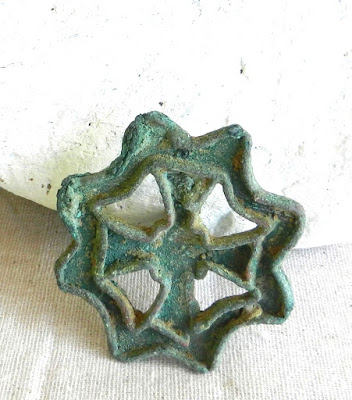Part 2 of the proposed routes from the steppes to the Murghab-Amu Darya and Indus Valley regions.
This blog does not attempt to discuss the proposed routes traveled by every migratory culture that settled in this region, only the Bronze Age culture known as the Bactria-Margiana Archeological Complex. The most detailed publications on the subject that I have read through the years are (1) Victor Sarianidi,
Myths of Ancient Bactria-Margiana on Its Seals and Amulets; (2) J. P. Mallory,
In Search of the Indo-Europeans; and (3) David W. Anthony,
The Horse, the Wheel and Language.
Sarianidi is the foremost field archeologist and publisher of material on the Bactria-Margiana Archeological Complex. Mallory is a historical anthropologist and wrote the afterword for another of Sarianidi's work,
Margiana and Proto-Zorastrism. Anthony is an anthropology professor at Hartwick College in New York where he also teaches courses in archeology. For his work,
The Horse, the Wheel and Language, he won the 2010 book award, Society for American Archeology.
This will be a short blog on the proposed routes of migration following the archeological evidence that reveal burial customs.
Burials
One of the most interesting finds in the tombs of the proto-Iranian people that constituted the Bactria-Margiana culture (generally dated 2500 - 1600 B.C.) is the presence of domesticated animal burials, sometimes alongside the deceased human's body. Here is a photo of a buried horse, minus the head:
p. 128
Necropolis of Gonur, Sarianidi
But before we gallop forth on our horses, let us see all the possible routes that are scattered with the burial remains of settlers with related burial practices. J. P. Mallory considers the varied routes suggested by Marija Gimbutas as a possible solution to the origins of the cultures that this blog discusses:
Mallory, In Search of the Indo-Europeans
From left to right, the handwritten labels show the geographic expansion of people with similar burial rituals and related grave goods; Medi (Mediterranean); Bos (Bosphorus); the Black Sea and below it, Anatolia and the Red Sea; the Caspian Sea and below it the Tigris and Euphrates rivers flowing into the Persian Gulf; then farther right are the Aral Sea and the Indus River Valley.
Note that Gimbutas provided a map that suggests an expansion of what she called the Kurgan culture from settlements in the steppe regions from the Black Sea to the East of the Aral Sea. The Kurgan culture takes its name from the shape of the grave in which the deceased humans and sacrificial animals were placed. A kurgan is a pit grave with a rock mound above it. This type of burial was uncovered in the Russian steppes and dated to about 4,500 years B.C.
Gimbutas shows arrows indicating that some of people of the Kurgan culture went West from the steppes north of the Caspian. That would explain why the language of the people still living in parts of India and the people now living in Iceland speak a modern version of what we now classify as "Indo-European."
For our search it is important to note that the arrow pointing south from the Caspian region and the two arrows pointing south from the region of the steppes surrounding the Aral Sea show routes into the areas in which the later Bronze Age culture of Bactria and Margiana (ca. 2,500 - 1,600 B.C.) and the related Indus Valley were found by the archeologists.
Anthony p 249
The pit graves often contained not only the human remains but also pottery and ritually buried animals such as horses, cows and sheep. Above you see the location of a horse skull indicated by an arrow in the sketch of a disturbed burial. This archeological finding is dated to 4200 - 3700 B.C.
Below is a photo taken at an archeological site in Kazakhstan, in the steppe zone above the Caspian Sea. The remains are dated about 3700 - 3000 B.C. Many such excavated house pits yielded about 300,000 horse bones. In addition the hunters of this region left remains of large bovids (bison?), elk, deer, boar, bears, beavers, saiga antelopes, and gazelles.
horse burial 3700-3000 Anthony p 217
burial with pots, horse, and partial wheels Anthony p 398
The photos and drawings above show a "Chariot grave," in the kurgan style left by the Sintashta culture in the Russian steppes. Pottery, weapon points, a partial horse skeleton, horseback riding equipment such as cheek pieces, and spoked wheel impressions from wheels that had been set into slots in the floor of the grave.
The horse burials left a trail for archeologists to follow from the steppes to the oases along such rivers as the Amu Darya, the Murghab and the Indus. In future blogs we will discuss the archeological, the historic and the linguistic "solutions" to identifying the origins and the migrations of the proto-Indo-Iranians.
At some point in this series, I will post Anthony's proposed route of the people from Gimbutas' Kurgan Culture who went east from the zone of the Aral Sea.










































